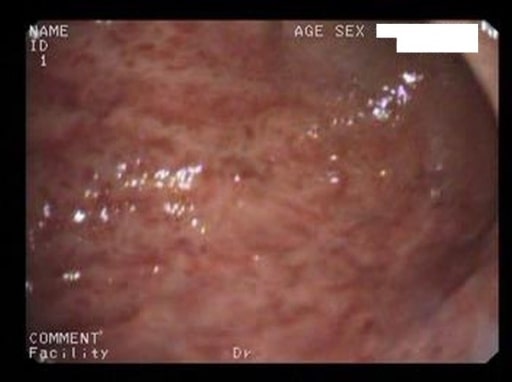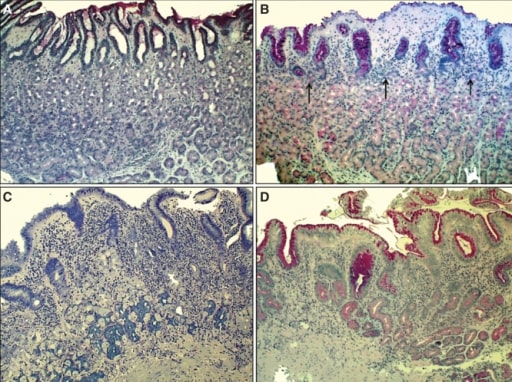Playlist
Show Playlist
Hide Playlist
Dysphagia
-
Slides GD Esophagus.pdf
-
Download Lecture Overview
00:01
With dysphagia, we’ll be looking at an algorithm,
and with the algorithm, as I told you earlier,
the objective of this slide is to
show you the behavior of the dysphagia.
00:14
If it’s solid food only that the patient
is suffering or experiencing dysphagia to,
what kind of differential… what kind
of description would you then call it?
Let’s talk about
intermittent at first.
00:25
Intermittent to you would mean that there is a fixed
obstruction in which the caliber of the esophagus is
becoming a little bit more narrowed making it difficult
for solid food to then transit through the esophagus.
00:41
And we will then describe in
great detail esophageal rings.
00:46
Even show you esophageal rings.
00:47
There’ll be quite a number of images here
that will do with endoscopy, upper endoscopy.
00:53
What if the patient says, “Hey Doc,
I’m having a hard time eating”,
“Oh, tell me about this difficulty
that you’re having with eating.
01:00
Is it with solids? Liquids? Tell me about how that occurs. Is it solids?"
“Yeah, I’m having a
hard time with solids."
“Okay."
“But you know what Doc, I would say about a year
ago I was having difficulty with solids but then
I noticed that now that I think about it, I was having a
hard time with drinking milkshakes couple months later."
“Hmm."
“And then it got to a point where I was having a hard
time you know, just about getting anything through."
That’s progressive.
01:31
Progressive.
01:33
See, initially the patient was having a hard time getting
solids through because of the bulky nature of it.
01:39
And as this obstruction started growing
within the esophagus, was making it more difficult
for other substances
to pass through as the substance
got thinner and thinner and thinner
referring to the fact that you’re moving
from solids towards liquid, and as
the obstruction is getting bigger.
01:55
Common sense.
01:58
Now, if it’s progressive and the patient
is also feeling “heartburn”,
then you should be thinking about peptic strictures
which we’ll talk about upcoming.
02:09
Now peptic stricture, different from a
ring because the stricture
represents the fact that there was well, hardening
that was taking place in the esophagus.
02:19
In the meantime, as far as the physiology is concerned
with the esophagus, remember that the esophagus is in the upper portion.
02:27
Skeletal muscles are there for more or
less under voluntary control but
for the most part though, you really don’t think
about getting food into the stomach.
02:35
So therefore, as you move down, distally through
the esophagus, then your muscle now becomes smooth.
02:41
In other words, involuntary.
02:44
Also with the esophagus,
physiologically you have peristalsis.
02:48
It’s nice and malleable.
02:50
It should not be hardened.
02:51
There shouldn’t be fibrosis.
02:53
It should be waves of peristalsis which then literally,
if you were to squeeze toothpaste, you’re moving the paste forward.
03:01
That’s exactly what’s
happening in your GI system.
03:04
So stricture, as we talk about this
later, is a disruption with that.
03:10
If there is no heartburn, as a patient
gets older, now this can be extremely concerning,
maybe perhaps there’s
esophageal cancer that’s involved.
03:22
And with esophageal cancer in esophagus, once again it’s
a fact that you have to come back to the histology to pay attention to well,
what was the nature and what was the
trigger for this particular type of esophageal cancer?
What do you mean type?
Obviously there will be two major types
that we will discuss in our discussion.
03:41
And which we will take a look at our
squamous cell cancer and adenocarcinoma.
03:47
Point is, esophageal cancer even though technical as far
as cancer is concerned, it does move rather quickly.
03:55
In description for dysphagia,
it’ll be progressive.
03:59
Solids first then liquids as the tumor
grows, grows, grows, grows, grows
within the esophagus making it more
difficult for substance to pass through.
04:10
What if the patient was having dysphagia
to solids and liquids at the same time?
At the same time.
04:17
“Hey Doc, I’m having
a hard time eating."
“Okay, well tell me about
your eating pattern.
04:23
Is it solid foods that
you’re having issues with?"
“Yeah Doc, I’m having a
hard time having my dinner.
04:31
Having a hard time
swallowing my potatoes."
“Okay, and what about the liquids?"
“Yeah I’m having a hard time
passing through my juices."
“Hmm, well what occurred first?"
“Well, to tell you the truth Doc,
pretty much around the same time."
“Mmm, same time."
Dysphagia, intermittent
with chest pain.
04:54
Now we have diffused
esophageal spasms.
04:59
Comes back to your understanding once
again of physiology.
05:02
What does peristalsis mean?
Smooth coordinated movement so that you have
proximal constriction and distal dilation.
05:11
So that as you squeeze the esophagus, involuntary,
the propulsion movement of the food.
05:19
What… all of a sudden, you have diffuse esophageal spasms
in which you don’t have coordinated contraction of esophagus.
Then you would have issues with both
solids and liquids as far as swallowing.
Progressive, with this heartburn,
you should be thinking about scleroderma.
So here once again,
let’s say that you’re having a hard time but the progress
here mean for both solids and liquids
is having a hard time getting through
because scleroderma to you should mean
fibrosis - excess deposition of
collagen resulting in fibrosis of esophagus
making it pretty much a lead pipe.
And so therefore,
a progressive nature for both solids and liquids.
If there was no heartburn and there’s symptoms
at night, you should be thinking about achalasia.
Achalasia means lack of relaxation
of your lower esophageal sphincter for whatever reason.
I want to talk about both congenital and acquired.
06:19
If your lower esophageal sphincter doesn’t wish to open,
then what kind of dysphagia are you going to have?
Simultaneous solids and liquids.
06:28
A nice algorithm that you want to keep in mind as
you walk through the differentials for dysphagia.
06:33
Make sure that you’re able to pay attention
to the symptoms that the patient is clearly
expressing based on the accurate or focused
questions that you are then posing to the patient.
06:48
Dysphagia.
06:49
Mechanical causes : Strictures - It
could be either benign or malignant.
06:53
We’ll get into that in a little bit.
06:55
Webs and rings - You need to keep those
separate, and we will when the time is right.
07:00
Also, Diverticula and hernia.
07:04
Inflammatory conditions
of the esophageal lining.
07:06
All of this are mechanical
causes of dysphagia.
07:10
Each one of these are
important differentials.
07:12
For example you’ve heard
of Zenker’s diverticulum.
07:16
The hernia here might
be of a hiatal hernia.
07:20
And inflammatory conditions, maybe your
patient is immunocompromised and so therefore
may be suffering from issues of
cytomegalovirus infection of the esophagus.
07:31
Dysphagia.
07:32
Functional type : Achalasia - the lower
esophageal sphincter doesn’t wish to open.
07:37
Failure of relaxation.
07:38
We’ll talk about a number of causes.
07:40
Scleroderma - increased fibrosis, thus there is going to
be dysphagia to both solids and liquids, progressive type.
07:49
Or the smooth peristaltic activity of the
esophagus has been lost, so therefore,
there will be increased pressures within the esophagus
resulting in lack of proper movement.
08:04
We call this, diffuse
esophageal spasms.
08:08
That is not a good thing.
08:12
Causes Oropharyngeal : Swallowing disorders
are usually neurological deficit.
08:16
So therefore, let’s say that your
patient has lost his or her gag reflex.
08:20
Hmm.
08:22
This is a problem.
08:23
You should be thinking about neurologic
issues such as Amyotrophic Lateral Sclerosis perhaps,
maybe multiple sclerosis, maybe
perhaps even diabetic neuropathy.
08:32
And so if there’s nerve damage that’s
taking place, there’s the gag reflex
that has obviously been lost, making it
difficult for the patient to swallow.
08:41
Keep that in mind because they
will then keep their food where?
In the mouth, because they
can’t swallow it properly.
About the Lecture
The lecture Dysphagia by Carlo Raj, MD is from the course Esophageal Disease: Basic Principles with Carlo Raj.
Included Quiz Questions
Which of the following medical conditions results in progressive dysphagia for solids and liquids with prominent nocturnal symptoms?
- Achalasia
- Esophageal ring
- Esophageal web
- Esophageal carcinoma
- Peptic stricture
Which of the following medical conditions results in intermittent dysphagia for solids and liquids that is associated with chest pain?
- Diffuse esophageal spasm
- Achalasia
- Scleroderma
- Esophageal ring
- Peptic stricture
Which of the following medical conditions is a functional cause of dysphagia?
- Achalasia
- Esophageal ring
- Esophageal web
- Peptic stricture
- Esophageal diverticula
Which of the following medical conditions results in oropharyngeal dysphagia?
- Multiple sclerosis
- Achalasia
- Esophageal ring
- Peptic stricture
- Esophageal web
Customer reviews
5,0 of 5 stars
| 5 Stars |
|
2 |
| 4 Stars |
|
0 |
| 3 Stars |
|
0 |
| 2 Stars |
|
0 |
| 1 Star |
|
0 |
very good approach to the problem of dysphagia, clear algorithm to reaching the diagnosis.
Very nice topic told very clearly and every thing is clearly underdtood






